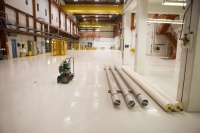 |
 |
|||||||||||||
|
|||||||||||||
|
|||||||||||||
|
With a brand new floor and freshly cleaned out space, Fermilab's New Muon Laboratory is about to become the new home to a sixty-metre-long accelerator that will serve as a test area for ILC R&D. Until recently, the New Muon Laboratory housed the 2000-ton Chicago cyclotron magnet for more than 24 years. The newly renovated area will now be used to test cryomodules for the ILC with an electron beam.
A main section of the facility will be devoted to a 75-metre-long test cave that will house three cryomodules. Each 12-metre-long cryomodule will contain eight superconducting cavities in a vacuum-sealed container that will be cooled down to 1.8 degrees kelvin. Together, the three cryomodules plus the radio frequency (RF) power systems will make up one complete RF unit for ILC R&D. The facility will also contain a brand new control room and cryogenic system. “We are in the final stages of getting the building prepared,” said Fermilab Project Engineer Jerry Leibfritz. “There is not a lot of visible progress right now, because we are getting the building ready and laying out the engineering details on paper, but that will change very soon.” Over the next few years, each cryomodule will be installed one at a time. Plans call for the first cryomodule, an “ILC kit” from DESY, to be installed in the facility this autumn. The second cryomodule will be installed in 2008. A 5 MW (megawatt) RF system, located right outside the test cave, will power these first two cryomodules. While the first two cryomodules will be a 3rd generation design (Type III+), the final cryomodule will be the new 4th generation design (Type IV). This 4th generation cryomodule will be the first one ever built, and testing it will play an important role in determining the final cryomodule design for the ILC. Testing this last cryomodule, however, will require a larger, 10 MW RF system. Current plans call for installing a Marx modulator, developed by a team at SLAC, to generate the extra power necessary to operate a complete RF unit. This new type of modulator has already reached important milestones at SLAC and, if successful, will make it feasible to provide power to accelerate the particles in the ILC in a more reliable but less expensive way. While the main purpose of this facility is to test cryomodules with beam, scientists from around the world will also be able to use the facility for a number of other ILC R&D purposes including the testing of controls, diagnostics and instrumentation. In addition, plans call to eventually extend the building so that it will be long enough to contain two complete RF units. “The plan is for the building extension to be a mock up of a portion of the ILC Main Linac Beam Tunnel,” Leibfritz said. “This facility will be very useful not only for global ILC R&D but also for other superconducting RF projects at the lab.” -- Elizabeth Clements |
|||||||||||||
| © International Linear Collider |
